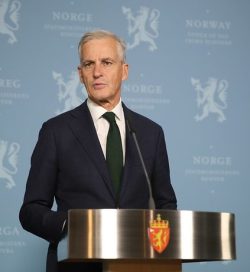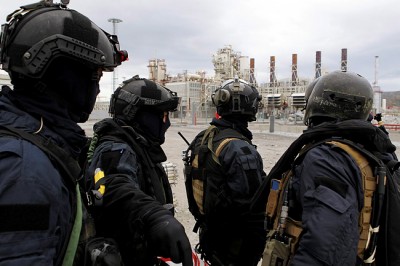UPDATED: Norwegian naval vessels were sailing out to offshore oil and gas installations on Friday, and may be joined by NATO allies, after more reports of unidentified drones flying around the Ekofisk field. Since the installations are now considered targets tied to Russia’s war on Ukraine, as is Norway’s vast network of gas pipelines, many feel the war is coming much closer.

“There’s been a dramatic development of the war,” editorialized newspaper Dagsavisen, for example, adding that damage to Russia’s own pipelines in the Baltic earlier this week sends “an overly clear signal on the capacity the enemy has to ram us.” Norway is now considered an “energy lifeline” to Europe after Russia cut off its gas deliveries to the continent in what EU and Scandinavian leaders view as a “divide and conquer” strategy aimed at lessening Europe’s support for Ukraine.
With Norway now supplying at least 40 percent of the EU’s gas, security and preparedness around its production and transport is suddenly being beefed up. “Defense forces have increased their visibility and presence in the areas around our oil and gas installations,” Marius Vågenes Villanger of the Norwegian defense’s operative headquarters told Norwegian Broadcasting (NRK) on Friday afternoon. “This applies to presence and patrols with forces both on land, in the air, at sea, under water and in the cyber domaine.”
He stressed that the drone activity, most recently around the Ekofisk field, “is a police matter,” and oil company Conoco Phillips confirmed it was “cooperating with the authorities” after new drone sightings. Drone observations made by military vessels will be shared with the police.
Prime Minister Jonas Gahr Støre later announced at a press conference that his government had accepted an offer of foreign allies’ presence on the Norwegian Continental Shelf as well. Germany, France and Great Britain will help Norway further boost security, Støre said.

“We have no indications of direct threats to Norwegian oil and gas installations,” he said, claiming security is already “high” and that the extra protection is part of “strengthening cooperation with Norwegian companies.” He planned to fly out to the Sleipner platform himself on Saturday, to meet with offshore workers after last week’s pipeline explosions.
Støre also used the occasion to condemn Russia’s decision on Friday to annex four regions of eastern Ukraine. While Russian President Vladimir Putin justifies the annexation through what’s internationally regarded as an illegitimate referendum in the area this week, Støre like other state leaders around the world called Putin’s annexation “a serious violation of the rule of law and can’t be accepted.” He added that it will “only contribute to further escalation of a dangerous situation.”
“We’ve gone from a peaceful situation to a sharpened situation,” Torill Herland of the naval defense forces told NRK earlier in the day. The drones around offshore rigs have raised concerns among helicopter pilots shuttling back and forth to them and from labour unions representing workers on board. Drones have also been seen around the Snorre A, Gullfaks C, Johan Sverdrup and Gina Krog platforms.

They’ve also been spotted around land-based energy installations including refineries, pipeline bases and electric power plants. NVE, the state waterways and energy agency responsible for Norway’s hydro-electric power, has also reported drone sightings, as has the power distribution firm Elvia.
Police, military and research officials believe foreign powers, likely Russian, are behind the drone activity but Erik Reichborn-Kjennerud of the foreign policy institute NUPI discounts any full-scale attacks on Norwegian infrastructure that could trigger a NATO response. “The potential is there, but Russia doesn’t have conventional means of attacking a NATO country (like Norway),” he told NRK. “It won’t be a full-scale war that would have be fought with nuclear weapons. It’s that or nothing.”
‘Alarming’
Others aren’t so sure, with some residents of areas near suspected energy targets getting increasingly nervous. “It’s alarming that we’ve had drone observations,” said Jon Askeland, local mayor near Equinor’s large facility at Mongstad.

Norwegian officials have also come under criticism for failing to beef up security sooner. Tor Ivar Strømmen, a researcher at Norway’s naval defense college (Sjøkrigsskolen) is among those criticizing how Norway hasn’t reacted earlier to suspicions of Russian vessels mapping Norway’s sea floor and pipeline routes. Newspaper Aftenposten reports that Norway’s police intelligence unit PST has warned of the potential for pipeline sabotage, most recently in 2020, but the police and military have never trained together on preventing or responding to it. They’ve had lots of joint anti-terror exercises in recent years, also involving oil platforms and staged hostage situations, but not involving pipelines. That’s likely to change: “The military has lots of sensors that can be used to reveal abnormalities,” Torbjørn Bongo, leader of the Norwegian officers’ and specialists’ union, told Aftenposten.
This week’s explosions around the Nord Stream pipelines in the Baltic were at any rate expected to alter the risk scenario and how to address it. NRK reported Friday morning that all nine politial parties in Parliament were huddling in a closed session of the expanded foreign policy and defense committee, and receiving a new “orientation” from the government. That preceded Støre’s press conference.
It’s difficult if not impossible to monitor Norway’s nearly 9,000 kilometers of pipelines and cables running from platforms and the mainland to the UK and Europe. Dagsavisen editorialized, however, that “securing this type of infrastructure is now national and European security policy.” Prime Minister Jonas Gahr Støre has promised more military presence offshore and NATO Secretary General Jens Stoltenberg has claimed that any intentional attack on allies’ critical infrastructure “will be met with a collective and decisive response.”
The UN Security Council, of which Norway is a member, was also set to meet on Friday. Russian officials have already blamed the suspected pipeline sabotage on the US, and suggested it was carried out by the UK and Norway. Aftenposten cited one Russian media report that Norway was involved because “it didn’t want to give Germany a chance to get Russian gas.”
As accusations flew in both directions, Aftenposten also published chilling photos of Russian special forces reportedly attached to a military and intelligence base in Kaliningrad in the eastern Baltic. The photos were reportedly taken in 2016 and they showed military divers training underwater, allegedly skilled in exploding boats, damaging cables and other infrastructure. Russian officials were quoted at the time as saying that “our combat divers are able to destroy all targets under water and above the surface, everything from NATO’s missile defense to offshore oil platforms and gas plants.”
NewsinEnglish.no/Nina Berglund

